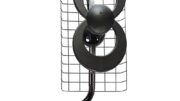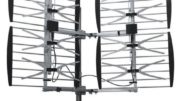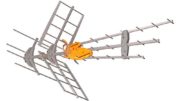Many of our customers are disappointed when they find their best choice is a big, old-school antenna like the one pictured above. They hoped they could use one of the new cooler antennas, only to find that they need something that looks like it crept out of the 1950s.
The real reason you need a “yagi” antenna like the one above is VHF performance. Those new-style antennas really perform best with UHF and they don’t always pick up VHF signals.
What’s the difference?
VHF signals, which are under 216MHz, require longer antenna elements and their nature says that every element should be “tuned” for just the right frequency. That’s why the big antennas have so many elements… to get the best possible reception on every channel. UHF frequencies respond much better with a single “loop” or “bowtie” type antenna design and that’s what makes it possible to have such small antennas that work well for all UHF frequencies.
How do I know what I need?
It used to be easy. If the station was on channel 2-13, that was VHF. Everything higher than that was UHF. However, with the PSIP system used for broadcasting today there is absolutely no correlation between a channel’s number and its frequency. Several web sites will help you with a lookup but it takes a lot of time. Your Solid Signal team can help. If you do need a VHF antenna and your stations are more than 30 miles away, it’s going to take one of those old yagi types to make it work; that’s just the way it is.
“That’s a load of hooey. Can’t someone do something about it?”
For what it’s worth we agree. The original plan for the 2007-2009 digital transition had all broadcasters going UHF, while it turns out that about a quarter of them stayed on VHF.
And it’s not going to get better.
For the last several years, the FCC has been actively planning to move more stations to VHF, not fewer. The FCC is taking away channels 37-51. As a result, most broadcasters are changing frequencies. Some of those broadcasts are moving to VHF channels. The good news there is that most of the VHF channels are going to be occupied by independent stations — in other words not network affilates. In addition, most of those VHF assignments will be on channels 7-13. Those channels still work with a relatively small antenna. You really only need the very large antennas to get channels 2-6.
In the last several years, Solid Signal has been aggressively beefing up our product selection with more UHF/VHF antennas. You’ll find the best products in our history, and they’re all clearly labeled with UHF and VHF range. Choose the antenna that works best for your area. Don’t know what’s going to work for you? You can get a free recommendation, or just choose a UHF/VHF antenna. You can’t go wrong. Buying an antenna that’s too big won’t hurt you one bit.
So yes, those old-school yagis will probably fade into history at some time, but it’s still going to be a while.





